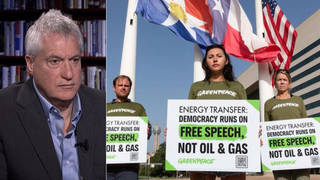
While offshore drilling has drawn national attention, less has been made of oil and gas drilling on public land within the continental United States. This despite figures showing the amount of oil and gas drilling on public land has reached a new high. The Wilderness Society recently reported more than 44 million acres of public lands are leased for oil and gas development. [includes rush transcript]
Transcript
AMY GOODMAN: We turn now to the rise in gas prices, Americans facing increasing calls to accept expanded energy exploration at home. Well, last month, both President Bush and Republican presidential candidate John McCain called for lifting bans on offshore oil drilling. Bush’s proposal included removing the ban on drilling in the Arctic National Wildlife Refuge. McCain says he’ll support the ban — the lifting of the ban.
While offshore drilling has drawn national attention, less has been made of oil and gas drilling on public land within the United States. This despite figures showing the amount of oil and gas drilling on public land has reached a new high. The Wilderness Society recently reported more than 44 million acres of public lands are leased for oil and gas development. Last year the Bush administration approved over 7,100 drilling permits, a new record. According to the Wall Street Journal, more rigs are currently operating in the US than at any point in over two decades.
But in states across the country, local residents are organizing to halt what they call the destructive effects of oil and gas drilling in their communities. This includes here in Colorado. Last year, a survey of more than 275 energy companies ranked Colorado as the world’s most attractive investment area for oil and gas exploration. But public backlash has forced a wave of pending measures. These include a three-month ban on drilling in wildlife breeding grounds and revoking more than $200 million in tax breaks for the oil and gas industry.
Nada Culver is senior counsel at the Wilderness Society, which works to preserve wilderness and other public lands in the US, joining me here in Denver at Free Speech TV’s studios.
Welcome to Democracy Now!
, Nada.
NADA CULVER: Thank you.
AMY GOODMAN: Talk about the state of drilling, not offshore, that’s gotten a lot of attention now, but onshore.
NADA CULVER: Well, the bulk of the drilling you talked about, 44 million acres, to give people some perspective, that’s the size of the state of Missouri, roughly. It’s hard to comprehend when we talk about just millions of acres and thousands of permits. And what’s been going on out here is we’ve seen the bulk of that in the five Rocky Mountain states — Colorado, New Mexico, Utah, Montana and Wyoming — where we’re seeing more than 30 million acres under lease. And at the same time, we’ve seen unprecedented rollbacks in environmental protection, things that would protect water, wildlife, air, wilderness, things that are, unfortunately, right now, by this administration, characterized as impediments to drilling.
AMY GOODMAN: Who is doing the drilling?
NADA CULVER: Right now there’s a host of oil and gas companies doing the drilling. But what ties it together is it’s managed by the federal government. The federal government owns millions of acres of oil and gas, and they lease it out to for-profit companies who drill it for their profit, which would tie to their record profits, while a portion of it does go to the American people, as well.
AMY GOODMAN: What can be done at this point, do you feel? And what are the communities where this is being played out, where people are objecting? And what are the communities where they support it?
NADA CULVER: Right. It’s pretty much the communities on the ground where we are having the oil and gas development, are almost uniformly asking for some measure of sanity and some measure of balance. We have communities like Pinedale, Wyoming, where there’s been a prize mule deer herd. In four years of drilling, the mule deer reduced 46 percent. A remote county, where they’re having ozone warnings because their air quality is like Los Angeles or Houston. In Colorado, we’re having water contamination from oil and gas.
And what we’ve seen is citizens getting involved like never before, trying to protest leases and ask for more protections. And we’re seeing the states themselves, the state of Wyoming, asking — requiring oil and gas companies to notify owners before they drill on their land and try to reach an agreement. The state of New Mexico stopping oil and gas companies from just putting waste materials into pits in the ground that are unlined. We’re seeing a real groundswell, especially in the Rockies, where we are seeing the impacts on the ground.
AMY GOODMAN: Can you talk about the moratorium, calls for moratoriums on drilling?
NADA CULVER: There have been a number of different calls for a moratorium on drilling, once again kind of a restore the balance. I mean, with the 44 million acres under lease, the sad part of that is that less than 12 million acres are in production. So there has been a question as to why do we need to continue to lease more and lease more and issue more permits, when we have thousands of permits unused and millions of acres sitting by, and yet what we get are more and more calls for more leasing, more drilling permits and more rollbacks of environmental protections. So, right now there are not any moratorium in place on federal lands, but some states and some counties, like in New Mexico, have actually enacted their own bans on further leasing, trying to protect their natural resources.
AMY GOODMAN: How do they do that? And what are the forces arrayed against them?
NADA CULVER: Well, they passed an ordinance to indicate that they do not want any more leases issued in their county, or they — and they will impose things like requirements for protecting watersheds and wildlife. And each time, what uniformly happens is there’s an immediate outcry that the sky is falling, we will all basically go hungry, go cold, go naked in the streets, because this will be the final straw, and there will never be any oil and gas production, and all the oil and gas companies will leave those states. And so far they’ve left New Mexico, Colorado, Wyoming and Montana over different ones, and yet they really haven’t. So that’s the uniform of what’s arrayed against these places, that are really just seeking a measure, I think, of sanity. And instead, we get very hysterical rhetoric from the oil and gas companies. Right now in Colorado, if you — despite this poll you just cited that this is the best place, all of a sudden we’re considering some very realistic and reasonable restrictions and protections for our water and wildlife, and all of a sudden Colorado is the worst place, and they’re all going to have to leave, except they all just said they were leaving New Mexico for protecting water, and Wyoming for protecting private property holders, and Montana for protecting water.
AMY GOODMAN: What actually happens with onshore drilling?
NADA CULVER: In terms of the process?
AMY GOODMAN: Yes. And what happens to the land?
NADA CULVER: So, once a lease is issued, it’s good for ten years, at least. And it can be held indefinitely as long as there’s some indication of production. So once it’s turned over to an oil and gas company, it really precludes other uses, things like wildlife habitat or recreation or wilderness. And those are the things that we focus on at the Wilderness Society, all the other uses for the public lands and all the other values they hold. What we’re seeing now with the amount of drilling that’s happening is we see wildlife habitat fragmented into unusable sizes. In other words, there are so many pipeline and well paths and roads that animals like mule deer and elk can’t survive. We see, for instance, in Nine Mile Canyon in Utah, a place renowned as an outdoor museum of rock art, the dust and chemicals used for dust suppression for oil and gas trucks are destroying these amazing pictographs that have survived for thousands of years. So those are some of the types of destruction we see from the mass scale of drilling.
AMY GOODMAN: Nada Culver, I want to thank you for being with us —-
NADA CULVER: Thank you.
AMY GOODMAN: —- with the Wilderness Society, based here in Denver, Colorado.













Media Options